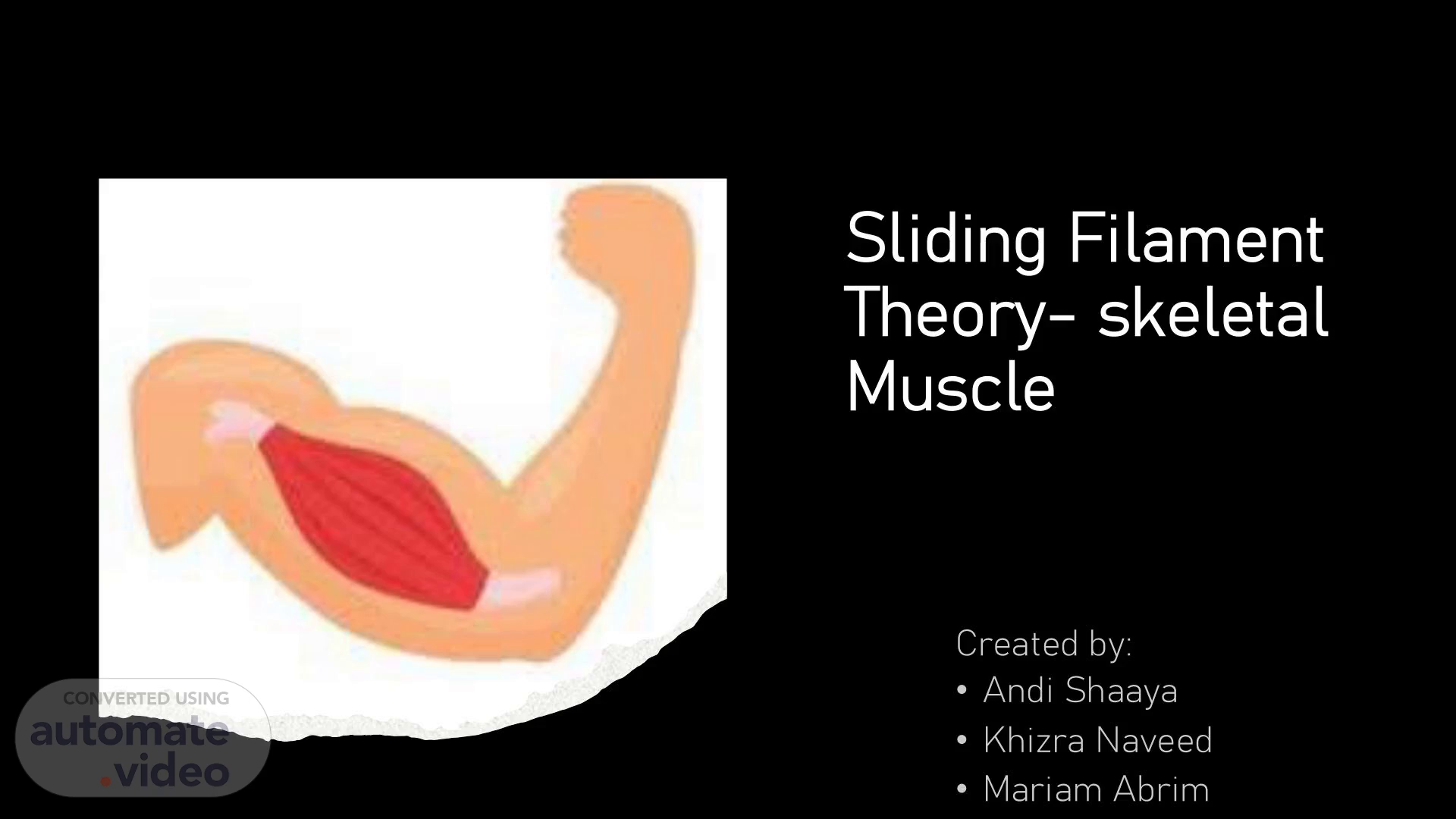Scene 1 (0s)
[Audio] Sliding Filament Theory- skeletal Muscle.
Scene 2 (6s)
[Audio] Have you ever wondered how your muscles make your body move? Well, you're in the right place! Just spare a few minutes, and we'll walk you through how it all works.
Scene 3 (17s)
[Audio] There are three types of muscles in your body: skeletal, cardiac, smooth muscles https://old-ib.bioninja.com.au/higher-level/topic-11-animalphysiology/112-movement/types-of-muscles.html.
Scene 4 (31s)
[Audio] Study.com Tendon Definition, Anatomy & Function ....
Scene 5 (39s)
[Audio] Ever wondered what's happening inside a muscle when it contracts? It all starts with muscle cell, also known as a muscle fiber, which are long and packed with tiny units called sarcomeres- the basic units of contraction. Inside each sarcomere are key proteins: Actin (thin filament),myosin (thick filament)- these proteins don't shorten, but they slide past other filaments during contraction. https://www.labxchange.org/library/items/lb:LabXch ange:4ead7bbb:html:1.
Scene 6 (1m 11s)
[Audio] Let's dive in neuromuscular junction: where nerves meet muscles Ever wonder how your brain tells your muscles to move? It all starts at this special connnection called the neuromuscular junction https://ncdnadayblog.org/2023/04/14/neuromuscularjunction/ This junction is where a motor neuron communicates with a muscle fiber, and it includes three key parts: - The axon terminal - The synaptic cleft - The motor end plate.
Scene 7 (1m 39s)
[Audio] https://www.google.com/url?sa=i&url=h ttps%3A%2F%2Fen.wikipedia.org%2Fwi ki%2FEndplate_potential&psig=AOvVaw3pQ6bZp WIYrqwLgAe47n1k&ust=174856944847 2000&source=images&cd=vfe&opi=899 78449&ved=0CBcQjhxqFwoTCNiWu5jH x40DFQAAAAAdAAAAABAE.
Scene 8 (2m 31s)
[Audio] Now let's look at action potential and Acetylcholine receptors The action potential activates receptors which acetylcholine (ACh) release from the action potential. ACh then binds to receptors on the motor end plate of the muscle fiber. https://images.app.goo.gl/buETKTAkwciqGbTt6 Acetylcholine (ACh) is a chemical messenger- also called a neurotransmitter- that helps nerve cells communicate with muscles..
Scene 9 (2m 58s)
[Audio] It all starts with a signal and a tiny chemical called acetylcholine unlocking the door to muscle movement. The binding of acetylcholine to receptors on the motor end plate opens ligand- gated ions channels, allowing sodium ions (Na+) to enter the muscle cell. This causes depolarization of the muscle membrane, which can lead to muscle contraction. https://images.app.goo.gl/bN82t2PBTUmZL4 Fi6.
Scene 10 (3m 23s)
[Audio] Once the signal is strong enough, it spreads like a wave through the muscle. action potential in muscle slideing scromeee Once the end plate potential reaches threshold, it triggers the opening of voltage- gated sodium channels in the surrounding muscle membrane. This generates a new action potential that spreads along the muscle fiber, leading to further steps in muscle contraction..
Scene 11 (3m 48s)
[Audio] Imagine the action potential racing deep inside the muscle through tiny tunnels- these are the T-tubules After the action potential propagates along the muscle fiber, it enters the Ttubules. This causes depolarization of the T- tubule membrane, which activates dihydropyridine receptors (DHPRs). https://quizlet.com/333181263/musclecontraction-flash-cards/.
Scene 12 (4m 11s)
[Audio] Now here's where the magic begins- two tiny receptors team up to unleash the power of calcium! https://www.jci.org/articles/view/25525/figure/1 The dihydropyridine receptors (DHPRs) physically interact with ryanidine receptors (RyRs), triggering the release of calcium ions (Ca2+) from the sarcoplasmic reticulum (SR). This interaction is crucial- without it, calcium would'nt flood the cell to start contraction..
Scene 13 (4m 39s)
[Audio] Now that calcium is released, it's time for it to do its job. Calcium ions (Ca2+) from the sarcoplasm bind to troponin on the thin filament, activating it. This causes tropomyosin to shift away from actin's binding sites, allowing contraction to begin. https://images.app.goo.gl/Tc4t5gdPR khXgCA67.
Scene 14 (5m 1s)
[Audio] Now the real movement begins Once the actin binding sites are exposed, the myosin heads attach to them, forming cross- bridges. The myosin heads use ATP to power their movement, pulling the actin filaments past the myosin filaments. This sliding action is what causes the muscle to contract. https://www.onlinebiologynotes.com/slidingfilament-model-of-muscle-contraction/.
Scene 15 (5m 26s)
[Audio] THANKS FOR WATCHING We hope you now have a better understand og the phsiology behind how your muscles really get moving!.
